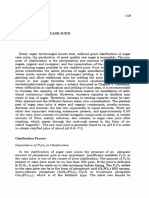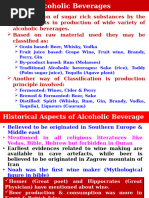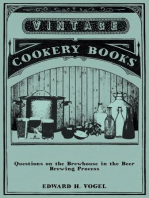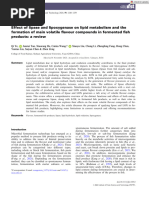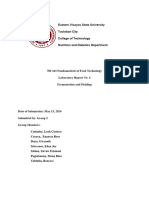Recommended Yeast For Rum: EDV 46 EDV 493 Superstart K1 WLP720 - Sweet Mead Yeast
Recommended Yeast For Rum: EDV 46 EDV 493 Superstart K1 WLP720 - Sweet Mead Yeast
Uploaded by
great2readCopyright:
Available Formats
Recommended Yeast For Rum: EDV 46 EDV 493 Superstart K1 WLP720 - Sweet Mead Yeast
Recommended Yeast For Rum: EDV 46 EDV 493 Superstart K1 WLP720 - Sweet Mead Yeast
Uploaded by
great2readOriginal Description:
Original Title
Copyright
Available Formats
Share this document
Did you find this document useful?
Is this content inappropriate?
Copyright:
Available Formats
Recommended Yeast For Rum: EDV 46 EDV 493 Superstart K1 WLP720 - Sweet Mead Yeast
Recommended Yeast For Rum: EDV 46 EDV 493 Superstart K1 WLP720 - Sweet Mead Yeast
Uploaded by
great2readCopyright:
Available Formats
Recommended Yeast For Rum
Yeast used in Rum Fermentations should allow for a good ester production that will combine pleasantly with acids produced by bacteria. The yeasts below are recommended for fermentation of Rum.
EDV 46 TM
Lallemand Lallemand White Labs Headquarters & Manufacturing Lab
7564 Trade St. San Diego, CA 92121,USA Tel: 858-693-3441 Fax: 858-693-1026
Rum
In the United States, rum is an alcoholic distillate from the fermented juice of sugarcane, sugarcane syrup, sugarcane molasses, or other sugarcane by-products. It must be produced at less than 190o proof in such a manner that the distillate possesses the taste, aroma, and characteristics generally attributed to rum, and bottled at not less than 80o proof.
EDV 493 TM Superstart K1
TM
Ethanol Technology Lallemand
WLP720 Sweet Mead Yeast
R&D Laboratory 2001 Second Street, Suite 2 Davis, CA 95618 USA Tel: (530) 756-2879 Fax: (530) 756-2870 Sales & Customer Service 5455 Spine Road Mezzanine East Boulder, CO, 80301 USA
Pure liquid yeast sized for approximately 200 gallons.
Tel: (888) 5-YEAST-5 (US & Canada) (303) 530-0469 (International) Fax: (888) 693-1026 (US & Canada) (303) 530-3816 (International)
Pure Yeast and Fermentation
Fermentation & Sugar Source
Its always a good idea to check a shipment of molasses by weight rather than a volumetric basis due to the variability of the effects of temperature on volume and density. When handling and storing molasses, avoid temperatures above 140o F as this promotes maillard reactions to occur with a resulting loss of sugar. Temperatures of 113o F are suggested. The purchase of molasses should be based on total sugar content and not brix, as the correlation between brix gravity, specific gravity, and sugar content is poor. For fermentation the concentrated molasses is cut with water to a gravity ranging from 20 25 brix. Cane juice on the other hand, with a sugar content of 12 16 % w/w sucrose, can be used as is for fermentation. Although abundant in fermentable sugars, any type of molasses or pure sugar fermentation medium is lacking in essential nutrients required by the yeast for a healthy metabolism. It does however have a healthy population of bacteria and or wild yeast that can take over fermentation, producing excess amounts of acetic and butyric acids which are toxic to yeast.
An acid addition is usually practiced to keep bacteria in check. Additionally excess salts and minerals can adversely affect yeast performance. A portion of dunder, the naturally fermented resi-
Types of molasses that can be used to produce alcohol
*Blackstrap molasses (traditionally used for dark rums) *High test molasses from evaporated cane juice (used for lighter rums) *Refiners cane molasses
Fermentation targets Gravity pH Duration Alcohol by Volume Start 13.5-25 Brix 4.8-5.2 End 0* 3.9
72 hours, may be as long as 96 120 hrs. 5-10 %
*Poor molasses can prevent good attenuation causing final gravity of >8
Recommended nutrient Go Ferm TM @ 2.5 lbs / 1000 gal @
due from a previous wash distillation, is normally pitched with a pure yeast culture for more complexity. Gentle aeration for the first 48 hours is beneficial for fermentation performance. Fermentation temperatures in the Caribbean can reach 90oF, however lower temperatures (75 80oF) will result in a better alcohol yield.
yeast rehydration DAP @ 2 lbs / 1000 gal @ start of fermentation TM Fermaid K @ 2 lbs / 1000 gal @ 1/3 depletion of sugar
Pitching rates 2 lbs active dried yeast / 500 gallons 4 liters liquid yeast / 1000 gallons *Always adjust pitching rate to Brix concentration*
Content Created for White Labs Inc by Clayton Cone & Christopher Bird
You might also like
- Competency Based Learning Material: Processing Foods by Fermentation and PicklingDocument11 pagesCompetency Based Learning Material: Processing Foods by Fermentation and PicklingJomari Palang-at Carnecer57% (7)
- Rum PDFDocument14 pagesRum PDFJojie-Ann Alabarca100% (2)
- DCL YeastDocument2 pagesDCL YeastACBNo ratings yet
- Exam 2 - 0Document193 pagesExam 2 - 0Claribel Sanchez100% (1)
- Production of Organic AcidDocument12 pagesProduction of Organic AcidMehwish MughalNo ratings yet
- Belle Saison Yeast Specification SheetDocument2 pagesBelle Saison Yeast Specification SheetSachin Darji0% (1)
- Best-Practices-1 LallemandDocument2 pagesBest-Practices-1 LallemandNoel GarciaNo ratings yet
- Rhone 2323Document2 pagesRhone 2323Anonymous ePcnZoBENo ratings yet
- Mastering the Boil Why Wort Boiling is Crucial for Brewing SuccessDocument2 pagesMastering the Boil Why Wort Boiling is Crucial for Brewing SuccessctdxxjasftmtwyfqlxNo ratings yet
- Lecture 1 - Fermentation TechnologyDocument15 pagesLecture 1 - Fermentation TechnologyNguyễn Minh KhuêNo ratings yet
- Winequip Datasheet CLOSDocument2 pagesWinequip Datasheet CLOSAnonymous ePcnZoBENo ratings yet
- Safale LA 01Document2 pagesSafale LA 01depechemodefanNo ratings yet
- IjgyhgDocument53 pagesIjgyhgMarc DiongcoNo ratings yet
- Beer Production: Nisma Farooq (Lecturer)Document41 pagesBeer Production: Nisma Farooq (Lecturer)Shanza LatifNo ratings yet
- GRG2008 BDocument19 pagesGRG2008 Bdancerdimon7No ratings yet
- Essential Yeast For Ale FermentationDocument2 pagesEssential Yeast For Ale Fermentationgabriel zambranoNo ratings yet
- BeerDocument38 pagesBeerAmalu Green ValleyNo ratings yet
- Production of Beers SlideDocument29 pagesProduction of Beers SlideNgọc Tín Kiều TrầnNo ratings yet
- Enoferm RP15Document2 pagesEnoferm RP15Anonymous ePcnZoBENo ratings yet
- BrewingDocument35 pagesBrewingVincent JingaNo ratings yet
- Setgn Alemu AaaaDocument28 pagesSetgn Alemu AaaaabrhshNo ratings yet
- CBC 1 DatasheetDocument1 pageCBC 1 DatasheetAntonio ImperiNo ratings yet
- Mauribrew Lager New TdsDocument1 pageMauribrew Lager New TdsManos NazlidisNo ratings yet
- Sfa S04Document1 pageSfa S04ietram12No ratings yet
- Brewers Pallette PosterDocument1 pageBrewers Pallette PosterAnonymous hP6ab2D1ppNo ratings yet
- Chapter 1Document8 pagesChapter 1Pablo EstebanNo ratings yet
- Thomas Hardy RecipesDocument4 pagesThomas Hardy RecipesTim McClureNo ratings yet
- Iso-Thermal Infusion Mash: Mashing Systems (Techniques)Document4 pagesIso-Thermal Infusion Mash: Mashing Systems (Techniques)Eduardo Herrera GnecchiNo ratings yet
- SafAle US 05Document2 pagesSafAle US 05Ime Nema ZimeNo ratings yet
- BeerRecipe 91 PDFDocument1 pageBeerRecipe 91 PDFAngel CarpioNo ratings yet
- Abbaye Belgian YeastDocument2 pagesAbbaye Belgian YeastArielovimagNo ratings yet
- Beer Production 1Document30 pagesBeer Production 1Lingaraj Kumar100% (2)
- Best-Practices-2 LallemandDocument2 pagesBest-Practices-2 LallemandNoel GarciaNo ratings yet
- Sugar IndustryDocument19 pagesSugar Industryprakas.rao39695No ratings yet
- Hidromiel BebidasDocument14 pagesHidromiel BebidasRuben 867No ratings yet
- Fermentis Tips TricksDocument20 pagesFermentis Tips TricksAntonio Imperi100% (4)
- Ethanol From Sugarcane JuiceDocument23 pagesEthanol From Sugarcane JuiceShrikrishna Gadkar100% (3)
- English Cider InstructionsDocument3 pagesEnglish Cider InstructionsVanderlei GeologoNo ratings yet
- Sefinew Asaye MeleeseDocument42 pagesSefinew Asaye MeleeseabrhshNo ratings yet
- The Influence of Mashing On Sour Beer ProdutionDocument17 pagesThe Influence of Mashing On Sour Beer ProdutionCristianoMacielNo ratings yet
- WINE PRODUCTS 2024Document27 pagesWINE PRODUCTS 2024gao shangNo ratings yet
- Slides Londhe Dec 2000Document20 pagesSlides Londhe Dec 2000RavikantNo ratings yet
- XaogDocument30 pagesXaogHandoko KartikaNo ratings yet
- Brewery Processes 407 2024Document20 pagesBrewery Processes 407 2024deensalihu07No ratings yet
- Food and Beverage ProcessDocument3 pagesFood and Beverage ProcessMark MagdirilaNo ratings yet
- MCB 407 Lecture 3Document6 pagesMCB 407 Lecture 3ejohn8340No ratings yet
- Homebrew - Fermentis GuideDocument16 pagesHomebrew - Fermentis GuideprofrodrigodaliaNo ratings yet
- TDS EN SafSour™ LP 652Document2 pagesTDS EN SafSour™ LP 652markNo ratings yet
- Asella Malt FactoryDocument23 pagesAsella Malt FactoryAbay100% (6)
- RAPIDORRDocument12 pagesRAPIDORRKris Flora100% (1)
- SFBT58Document1 pageSFBT58leotottiNo ratings yet
- Technology Alcoholic BeveragesDocument23 pagesTechnology Alcoholic Beveragesaksndri23No ratings yet
- All About HydrocolloidsDocument28 pagesAll About HydrocolloidsBambang NurhadiNo ratings yet
- Active Dry Wine YeastDocument5 pagesActive Dry Wine YeastoldpenguinNo ratings yet
- BeerDocument27 pagesBeerAbdisa Gemechu100% (1)
- Wolkite University: College of Engineering and Technology Departement of Food Process EngineeringDocument47 pagesWolkite University: College of Engineering and Technology Departement of Food Process EngineeringDani Tariku67% (3)
- Notes For Beer Mash & Chill Proofing, Molecular Markers Notes SummaryDocument24 pagesNotes For Beer Mash & Chill Proofing, Molecular Markers Notes SummaryANUPAM SINGLA0% (1)
- NNC BeerDocument39 pagesNNC BeerSYBSC 049 Shrishti K.No ratings yet
- Food & Beverage Service NotesDocument73 pagesFood & Beverage Service Notessanthosh manickamNo ratings yet
- Rum Cocktail Recipes: Ultimate Book for Making Refreshing & Delicious Rum Based Drinks at HomeFrom EverandRum Cocktail Recipes: Ultimate Book for Making Refreshing & Delicious Rum Based Drinks at HomeNo ratings yet
- Corporate Offer: Commodity: SpecificationsDocument1 pageCorporate Offer: Commodity: Specificationsgreat2readNo ratings yet
- Anf 2 A Application Form For Issue / Modification in Importer Exporter Code Number (IEC)Document6 pagesAnf 2 A Application Form For Issue / Modification in Importer Exporter Code Number (IEC)great2readNo ratings yet
- Mcoatt Lesson PlansDocument25 pagesMcoatt Lesson Plansgreat2readNo ratings yet
- Crossbow FullDocument4 pagesCrossbow Fulldamchilbert100% (7)
- SaltDocument1 pageSaltgreat2readNo ratings yet
- Malaysia 2Document15 pagesMalaysia 2MeeraSuhainiNo ratings yet
- Math You Can't UseDocument192 pagesMath You Can't UseJorge Eduardo SepúlvedaNo ratings yet
- Maters in EuropeDocument52 pagesMaters in Europegreat2readNo ratings yet
- Measuring Salts in SoilDocument8 pagesMeasuring Salts in Soilgreat2readNo ratings yet
- IMYB 2011 - Corundum & SapphireDocument5 pagesIMYB 2011 - Corundum & SapphireAamr BkNo ratings yet
- How I Made My Own Plasma Cutter From Junk: by Joe EichholzDocument51 pagesHow I Made My Own Plasma Cutter From Junk: by Joe EichholzFlavioacNo ratings yet
- Oil of MetalsDocument135 pagesOil of Metalsgreat2read100% (10)
- Finnish TutorialDocument32 pagesFinnish Tutorialgreat2readNo ratings yet
- Measuring Salts in SoilDocument8 pagesMeasuring Salts in Soilgreat2readNo ratings yet
- The Alchemical Apocalypse of Isaac NewtonDocument309 pagesThe Alchemical Apocalypse of Isaac Newtongreat2read83% (6)
- 11 CuresDocument105 pages11 CuresMartin Rodrigues100% (6)
- Bio 150 Experiment 3Document5 pagesBio 150 Experiment 3nordiana muhidinNo ratings yet
- Peristrophe Bivalvis: Research CommunicationDocument6 pagesPeristrophe Bivalvis: Research CommunicationAzizah MunitaNo ratings yet
- Methyl Red and Voges-Proskauer Test ProtocolsDocument9 pagesMethyl Red and Voges-Proskauer Test Protocolsemily zavaleta zavaletaNo ratings yet
- Advances in Preservation of Dairy and Food Products 2001Document261 pagesAdvances in Preservation of Dairy and Food Products 2001MohsinNo ratings yet
- Component Parts of FermentationDocument15 pagesComponent Parts of FermentationSavan VoraNo ratings yet
- 9th Grade Exploring LifeDocument99 pages9th Grade Exploring LifeYağız YiğitNo ratings yet
- SCIENCE 9 (1) - MELC 5 - Reviewed by CommitteeDocument14 pagesSCIENCE 9 (1) - MELC 5 - Reviewed by CommitteeBayani VicencioNo ratings yet
- Technical Description of BiorefineryDocument6 pagesTechnical Description of Biorefinerydannykusuma28No ratings yet
- Life ProcessesDocument92 pagesLife ProcessesPrasanna DeshmukhNo ratings yet
- Historical Context of Bars and Alcoholic BeveragesDocument36 pagesHistorical Context of Bars and Alcoholic BeveragesgizemtopbassgNo ratings yet
- Int J of Food Sci Tech - 2024 - Ye - Effect of Lipase and Lipoxygenase On Lipid Metabolism and The Formation of MainDocument12 pagesInt J of Food Sci Tech - 2024 - Ye - Effect of Lipase and Lipoxygenase On Lipid Metabolism and The Formation of Mainmattajunior7No ratings yet
- Cristalizacion de La Miel Metodo DyceDocument5 pagesCristalizacion de La Miel Metodo DyceOrlando BardalesNo ratings yet
- Inoculum DevelopmentDocument1 pageInoculum Developmentrocky00023100% (5)
- Whitepaper FermentatieDocument5 pagesWhitepaper FermentatieJelly NiNo ratings yet
- Lab Report Food Tec FinalDocument29 pagesLab Report Food Tec FinalKate Zybelle OberoNo ratings yet
- The Chemistry of Cooking and Cleaning - Ellen RichardsDocument106 pagesThe Chemistry of Cooking and Cleaning - Ellen RichardsSandra Mian100% (2)
- Microbial Community Analysis of Swine Wastewater Anaerobic Laggons by Next-Generation DNA SequencingDocument8 pagesMicrobial Community Analysis of Swine Wastewater Anaerobic Laggons by Next-Generation DNA SequencingDoulalas GiorgosNo ratings yet
- Edexcel Biology (9-1) Practical BookDocument55 pagesEdexcel Biology (9-1) Practical Bookgg6489105No ratings yet
- Basic Microbiology PracticumDocument11 pagesBasic Microbiology Practicumdiana sihotangNo ratings yet
- 15 International Biology Olympiad Brisbane, 2004: Competitor #Document62 pages15 International Biology Olympiad Brisbane, 2004: Competitor #SciOlympiad2345No ratings yet
- Synopsis : Various Sterilization Techniques of Fermentation MediaDocument3 pagesSynopsis : Various Sterilization Techniques of Fermentation MediaPratibha PatilNo ratings yet
- I P Sample (Complete)Document36 pagesI P Sample (Complete)Christian Angelo C. VelardeNo ratings yet
- Kyambogo Report 2Document9 pagesKyambogo Report 2Nkugwa Mark WilliamNo ratings yet
- Chapter 5 Cell Kinetics and Fermenter Design - PPT (Update) - 1 Bio GamalDocument101 pagesChapter 5 Cell Kinetics and Fermenter Design - PPT (Update) - 1 Bio GamalMatewos Sada100% (1)
- 10 Science Sample Paper CbseDocument13 pages10 Science Sample Paper Cbse123No ratings yet
- Complete Report On Formation of Poly Lac PDFDocument119 pagesComplete Report On Formation of Poly Lac PDFMadhukar Scribd0% (1)

















































